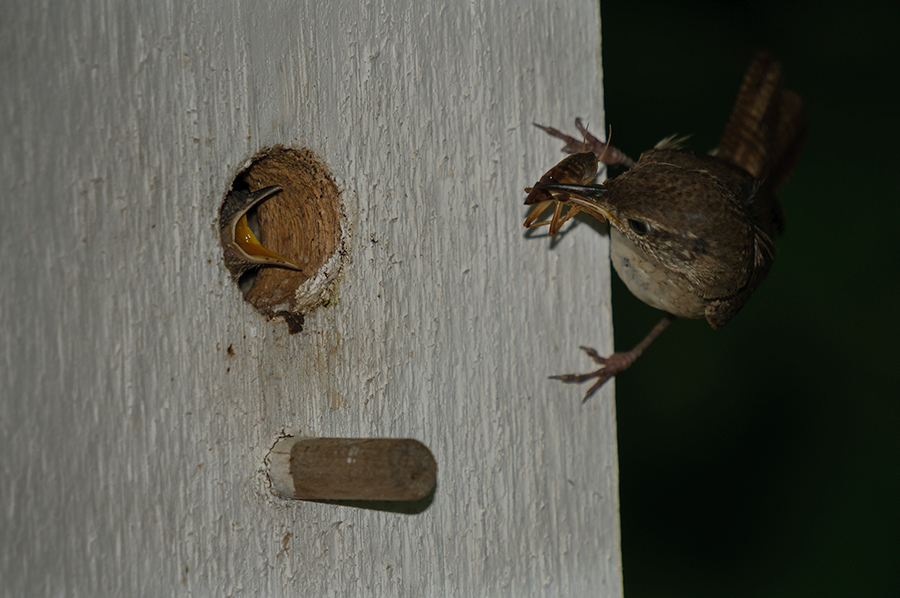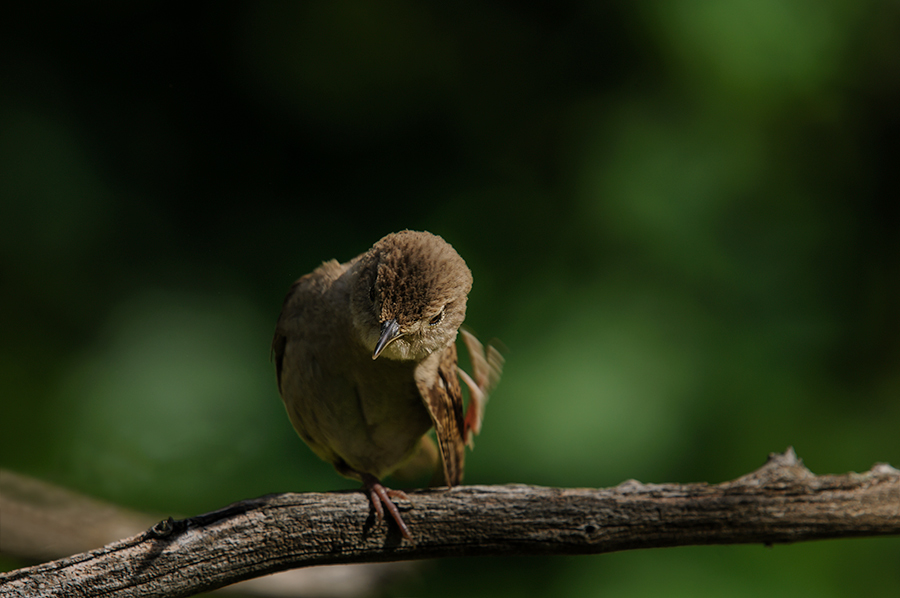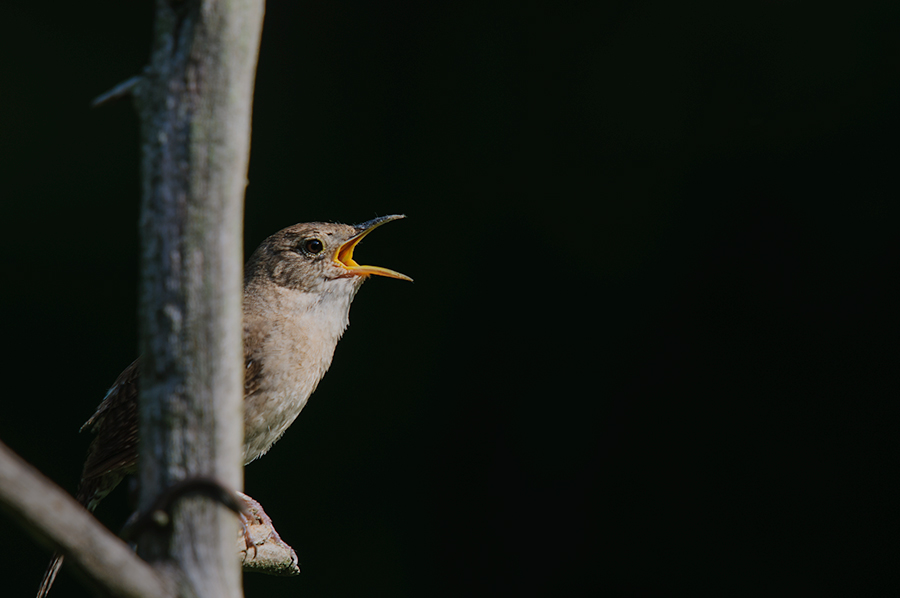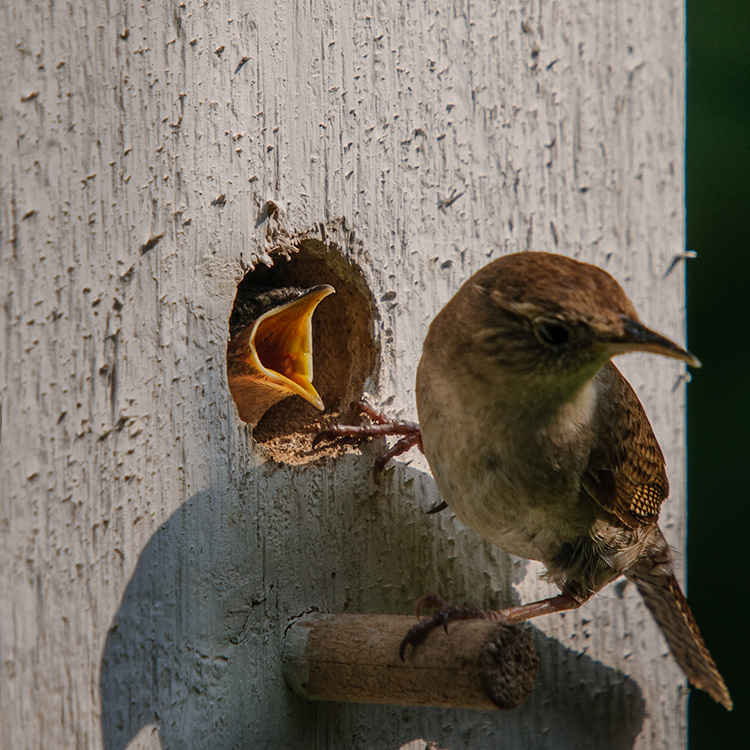
It was still feeding time yesterday and this morning at the wren bird box. I was too busy with other things this evening and don’t know if the young House Wrens have left their nest today or not. I guess I’ll find out tomorrow morning… ;-)

It was still feeding time yesterday and this morning at the wren bird box. I was too busy with other things this evening and don’t know if the young House Wrens have left their nest today or not. I guess I’ll find out tomorrow morning… ;-)

When I told you a few days ago that it will be quiet for the rest of the summer, because the little House Wrens had left their nest box, I did not know that in one of the other boxes at the edge of the woods another female was still sitting on her eggs. Well, since a few days we can hear their hungry chatter and the parents deliver insects and spiders every few minutes. We are very happy that we had four successful broods just within the range of our house this year. The parents approach the box always very carefully, especially if there is a guy with a tripod and camera not far from the nest.
I highly respect their privacy and use the full range of the long lens to make these images. By watching them for a while I knew that the old birds would always first land in a shrub nearby, then fly to a tree branch above the nest, before they finally go to the hole in the box with their food. Knowing the critters biology and habits leads to more photo opportunities and quite often to better results.

My instinct told me yesterday, take some pictures of the House Wrens, who were feeding their second brood this summer, because the young birds may leave the nest within the next few days. I’m glad I did, since it happened much faster than I thought. Early this morning I heard the parent birds calling the offspring out of the nest. At 7:30AM it was empty. Later during the day I heard them still chatter in the bushes around here and the parents do of course still feed them.

There is no other bird I have studied and photographed more than the little House Wrens during the last years. They raise the first brood every year in one of the bird boxes in the flower bed in front of our house. For the second one they prefer a hollow gourd that hangs from our porch.
There were at least two young wrens in the gourd, and boy, they were hungry. The little guys were calling for more food all day long and the parents of course delivered…
It will be quiet from now on in the morning for the rest of the summer. But when the snow starts falling later in the year we begin dreaming about the first signs of spring. The arrival and chatter of our House Wrens is definitely one of them…

There is a lot going on in the woods here again. Many young birds try to find their way around. The House Wrens from our second nest box left their nest finally Saturday morning. One of them found its way into our house but after five minutes I was able to catch the little guy and release him into the wild again. The male wrens are in full courtship again and try to impress a female by singing near any possible nest place. I have never seen the wrens using the same nest for their second brood and we will see what they do this year.

This is a young House Sparrow and the parents were nearby, still taking care for the offspring. It is the first time that we had House Sparrows having a nest somewhere close by.

I was happy to see five juveniles hopping around their parents on the ground today. This photo was made while a big thunderstorm moved into our area and it became quite dark. The fill flash makes the important, story telling parts standing out, the wide open beak and the eye of the young sparrow, as well the bill of its mother that stuffs the food into the throat…
(P.S.: In the first version of this blog post I said the sparrows in the last image were Chipping Sparrows. A closer look at some of my other photos made me recognize my mistake. They were all House Sparrows.)

Today the young House Wrens left their nest, at least at one of the two bird boxes we have installed for them in our front yard. Early in the morning one little wren was already outside of the box, sitting on a branch, but he may have returned later. There was a lot of calling going on by the adult wrens during the day and this happens usually when they try to lure the offspring out of the nest. This evening I saw one juvenile wren leaving the nest box and finally flying into the trees around. The mother still continued to feed the rest of the gang at least a few more times. I left home for half an hour and after my return it was quiet in the nest box. The first brood in 2014 had left the nest.

When I made the first two images this morning during a thunderstorm I had already the feeling that the young wrens were about to leave the nest soon. Didn’t know it would happen that fast. The parents will probably take care for the offspring for a few more days and than hopefully get ready for another brood. A few days ago I saw one of the males already building another nest in one of the other boxes we have in the yard and he was calling for a female’s attention like crazy…


I can’t resist to show you this photo of a male Northern Shoveler that I made last Sunday in the Green Island Wetlands. It took me several years to get this close to this colorful duck. It was slowly swimming along the shore and foraged by dabbling in the shallow water. They feed on tiny crustaceans, insects, mollusks, seeds, fish, and aquatic vegetation. I had to move my “mobile blind”, the car of course, several times to make this shot finally. It all came together, gesture of the bird, light, and colors…

I'm very happy to show you this image of a female Ruby-throated Hummingbird sticking its long tongue out. The photo was made with no additional light source, just the soft late morning light we had here last Saturday.
I always like to improve my photography and one way to do it is setting goals for myself. That means analyzing the previous work and developing new ideas of how to work with a known subject in a different way. At least I may try to catch a gesture that tells a story or is somehow different from anything I have done before. I have literally hundreds of pictures of the Ruby-throated Hummingbird on the hard drive but never made a sharp one with the bird sticking its tongue out. With other words, it was on my "most wanted list". This long tongue enables the hummingbird to go really deep into a flower and drink the nectar or drink the sugar water out off an artificial feeder. Because nectar is a poor source of nutrients they also prey on insects and spiders in order to cover their needs for protein, minerals, and vitamins.
Hummingbirds are only present in the Americas and can't be found in my home country Germany. In fact, I have never seen one in real life before I came to the US. Maybe that's why I get very excited any time I watch them or try to create an image with the camera. I hope you enjoy!

I'm glad I made these pictures yesterday because today the young wrens left the nest in the gourd that is hanging from our porch. We didn't know how many young House Wrens were in the nest until I saw three little birds today. They were sitting together in another bird's nest that is hidden in a bush just a few yards away from the house. The parents had obviously called them out one after another and gathered them with them in the new place. I believe the nest belongs to the Chipping Sparrows that have raised their offspring and are seen now in the grass teaching them how to catch a bug. The wrens didn't stay very long in this place. A few minutes after I saw them in the second nest they had moved already on and we could hear them chatter somewhere in the woods nearby. We wish them save travels and hope to see some of them next year in late April or early May again. They might be here still for a little while but usually we don't see them again after the second brood left the nest.

Let's talk about the photos I show you toady. The first one doesn't need much explanation. Two of the three young wrens sticked their heads out, waiting for food (the third one was probably pushed to the back by the more powerful siblings) and seeing them with their bills closed was a rare moment. They made a lot of noise yesterday and again this morning right after sunrise. The parents came very frequently with new food and it was a joy for me to capture those moments.

My wildlife photography has a lot to do with showing the beauty of wild living animals but the avid reader of my blog knows that I always try to shed some light on some interesting biological facts about the animals I photograph. I have cleaned many bird houses after the breeding season in the past and it always impressed me how clean they are inside. You don't find much dirt beside the branches and grass of the nest. The wrens remove their excrements instantly and I'm sure other birds do too in order to keep the place healthy. And here is how it works. Raising three, four, or even more young birds requires a lot of insects to be caught and fed to the offspring. The last two pictures are shot within a few seconds. The young bird receives its meal, swallows, turns around immediately, and hangs its butt out of the hole of the nest box. The parent bird picks up the digested food from the backside and flies away with it. When the wrens are very young this happens obviously inside the nest box and we can't see it but we always see the parent birds coming out of the hole with trash. I also saw sometimes the young bird giving the excrements to the parents with its bill. This might not be the most pleasent thing to see for some people but I believe it is very interesting. Being intimate with a critter's biology is essential for making the click at the right moment or to predict when the action may happen that you are waiting for. This includes that someone shows you their butt sometimes... ;-)


I wonder if you get bored by my little reports about some animals I follow with my camera throughout the season but at least I hope you enjoy the photos that sometimes can tell a story better than any words can do. One of the bird species I follow every year are the House Wrens that have their nest either in a bird box in our front yard or, like at the moment, in a gourd hanging from our porch. The young birds of the second brood are still in the nest and I was wondering why I saw suddenly four wrens sitting in the dead cedar branch that we use as a perch for the birds. The question was answered pretty fast when one of the adults started feeding one of them with an insect it just had caught. It was the offspring from their first brood that came "home" for a snack. Usually we never see them again after they left the nest but obviously they are still around here.

I have lots of photos from our wrens and the challenge is now to photograph them in a pose that is beyond the ordinary "sitting bird" pose. Some actions last only a couple seconds, like in the second image showing the bird scratching its neck. The other time to get the camera out is when a light situation looks promising. Early morning is a good time for it at our location.
The adult birds approach the nest every few minutes and always with food in their bills. The amount of food the young wrens eat is amazing. We still don't know how many juveniles are in the nest but I can tell you, they cry very loud as soon the adults bring another snack to the nest. Maybe that made their older siblings a little jealous and drew them back home, who knows... ;-)

It might be annoying for some people but I have no problem at all waking up every morning by the song and flutelike melody of the House Wrens that have their nest in a bird box just in front of our house.

They are extremely busy lately because their offspring needs a lot of food. Both parents care for the baby birds and bring grasshoppers, spiders, and caterpillars to the nest. The size of the pray becomes bigger as the young birds grow.

They stick their little head out of the hole and even if one of them had just received a meal they ask immediately for more as you can see in the third image. We don't know exactly how many baby wrens are in the nest. I have seen at least two at the same time but I believe there are at least three or four in the box. We expect them to leave the nest within the next few days and hopefully nothing will prevent them to grow up. Last year the first brood was destroyed by a raccoon. We have a another bird box behind the house and can hear the offspring of a second pair of wrens in this one as well. The frequent rain lately and the warm weather are ideal for all kinds of insects and the young House Wrens have obviously enough to eat. Beside the raccoons there is another predator around that likes to get a hold of the young birds, but this is for another post...